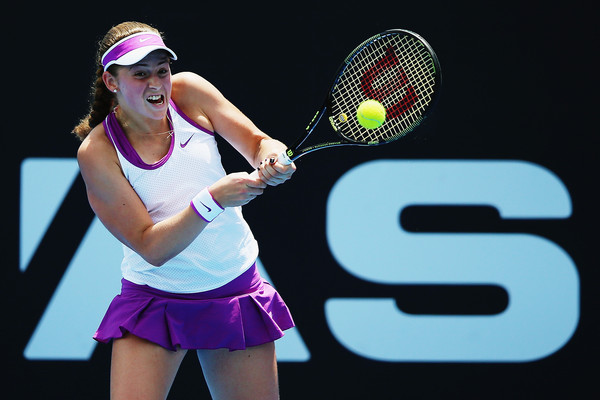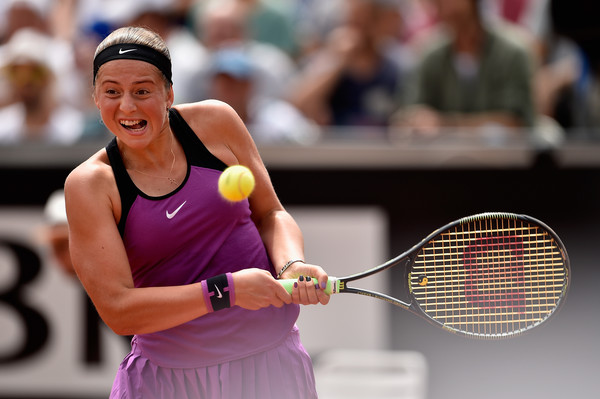Jelena Ostapenko is a part of the WTA’s bright future at the age of 19. Her feisty attitude and overwhelming power make her matches always entertaining to watch. With Wimbledon approaching, it is the perfect tournament for the Latvian teenager to continue her rise up the rankings. The 2014 Wimbledon Girls champion has high hopes for the year’s third major, but it is up to her if she can stay patient off the ground and control her temper to make a deep run.
She holds all the skills to make way into the top ten. Her entire game suits the quick, green surface from her serve to her groundstrokes. She holds impressive wins over Carla Suarez Navarro, Petra Kvitova, and Anastasia Pavlyuchenkova on the beloved British grass. Her inconsistent results this year may look concerning for the teenager, but with the right mindset and game plan, Ostapenko has the capability to make noise at the All England Club.
The world number 36 made her maiden grand slam main draw debut at Wimbledon 12 months ago. Since then, she has appeared in the main draw of the following three majors, but has only tallied just two total grand slam main draw wins and has yet to advance past the second round at any of the four majors.
Notable results to date
Ostapenko has had an up-and-down season on the WTA Tour. She currently holds a 16-16 record in 2016, which includes three losses in the qualifying, six first round losses, three second round losses, two third round losses, one semifinal loss, and one loss in a final. She opened her year up in disappointing fashion with just two wins in her first seven matches but quickly turned it around at the end of the Middle Eastern swing.
The teenager made her first deep run in Doha this February. With five consecutive wins over in-form players, the Latvian shocked the tennis world. Ostapenko went on to lose in the Qatar Total Open final to Suarez Navarro in three sets. But the Latvian’s impressive week vaulted her ranking from 88 to into the top-50. She reached her career-high ranking of 41 thanks to her brilliant week in Qatar.

After two disappointing tournaments in the United States, Ostapenko headed to Europe ahead of Roland Garros. But before the Latvian stepped foot on clay, she stopped in Poland to play in the Katowice Open which was played on quick, indoor hard courts. The third seed clinched wins over Daniela Hantuchova, Kristyna Pliskova, and Timea Babos to reach her second WTA semifinal in 2016. A loss to Camila Giorgi ended her tournament run, but the teen carried confidence heading into the clay-court season.
Following her semifinal appearance in Katowice, Ostapenko fell in her opening match in back-to-back tournaments. But she made her way to Rome for the BNL Internazionali d’Itlalia where she was to play in her final warm-up tournament before Roland Garros. She dropped just six games en route to the third round after comfortably beating Kristina Mladenovic and Monica Puig. The 19-year-old then fell to the eventual French Open champion, Garbine Muguruza, in straight sets. It was a positive week for Ostapenko as she tallied two high-quality wins despite playing on her worst surface.
The Riga, Latvia native then made an appearance at Roland Garros, but she was quickly overcome in her opener by Naomi Osaka. Her next tournament appearance came two weeks later in Rosmalen where she fell in the second round at the hands of Kateryna Kozlova. Her year had seemed to have gone downhill since Doha, but she ended her disappointment with a solid performance at the Aegon Classic. Ostapenko sent Pavlyuchenkova and Kvitova packing in Birmingham before falling in the quarterfinals to the eventual champion, Madison Keys.
Best grass results leading to Wimbledon
Ostapenko began her grass-court season at the Ricoh Open this year. She cruised past the qualifier Jovana Jaksic in her opener to set up a second-round matchup with Kozlova. The Ukrainian upset the fourth seed in straight sets, and the Latvian searched for answers to get her season back on track.
She then played in the WTA’s premier Aegon Classic. Two impressive wins later, Ostapenko found herself in her first quarterfinal in over two months. Despite leading a set and a break in her quarterfinal against Keys, she went crashing out, 6-7(1), 6-4, 6-2.

The 2014 Wimbledon girl’s champion headed to her final warm-up tournament before Wimbledon. Ostapenko ousted Daria Kasatkina after being a set down. But her time in Eastbourne was cut short as Dominika Cibulkova moved into the third round with a 6-3, 6-3 win over the top-ranked Latvian.
Best Wimbledon results
Ostapenko’s best Wimbledon result came in 2014 when she left the All England Club as the girl’s champion. She dropped just two sets in six match wins and executed 40 winners in her championship match against Kristina Schmiedlova.
Following her Junior Championships title victory at Wimbledon two years ago, Ostapenko told the media, "This is one of the best Grand Slams, and I love it here. The atmosphere, the grass courts, and the people are all really nice. I like how everyone plays in white clothes. This means a lot and is a good stepping stone." But now the 19-year-old is well inside the top-100 and is closing in on the top-30 and she holds bigger goals which include a deep run at her favorite grand slam.

Ostapenko has made one previous appearance in Wimbledon’s ladies singles competition. Last year, the world number 36 stunned Suarez Navarro 6-2, 6-0 in the opening round. But her tournament was soon cut short as she fell in the second round to Mladenovic. But Ostapenko walked away from the prestigious venue with having won her first main draw match at a major which ultimately was the turning point in her career as she gradually began to compete at the WTA level week in and week out.
How Ostapenko’s game translates to this surface
Ostapenko’s style of tennis suits faster surfaces as she can utilize her power and flat ball-striking to create a quick, low-bouncing ball to trouble her opponents. She possesses an aggressive mindset and she attacks relentlessly, but especially off of her forehand side. Her fearless offense allows her to dictate play, which is crucial on the grass courts.

Her ability to change the ball’s direction is pivotal on the slippery surface. The teen’s forehand, in particular, tends to be unpredictable as she can place it anywhere from down the line or crosscourt, not to mention her killer inside-out groundstrokes. All in all, if Ostapenko can maintain a steady attitude and play her game, then she should make a solid run at Wimbledon.






































